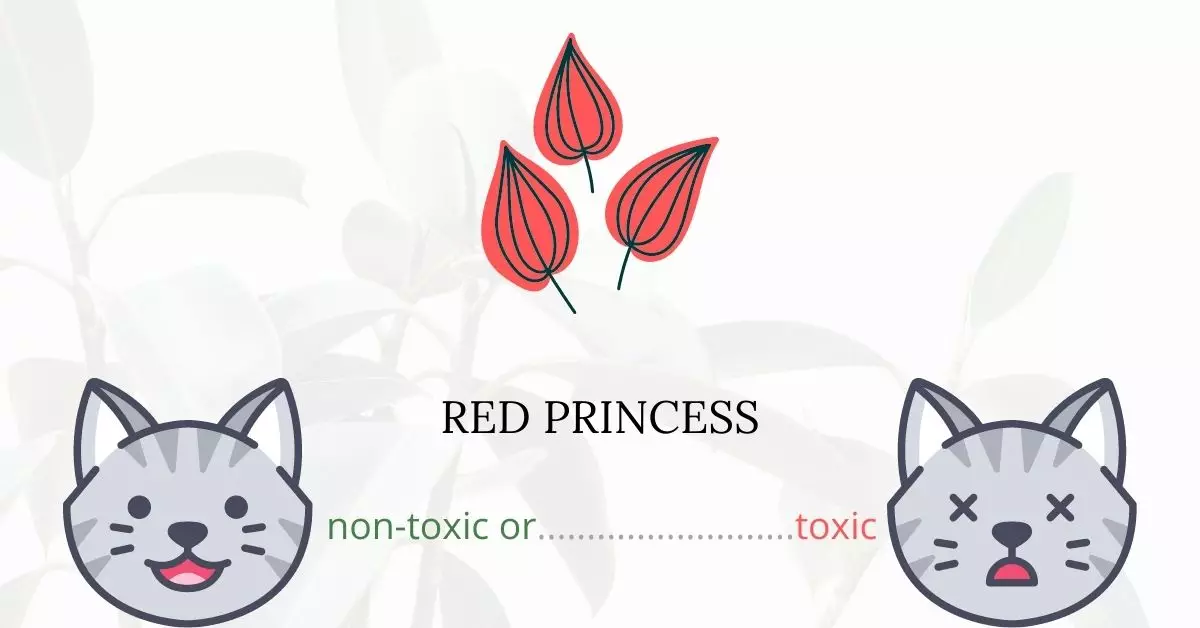The Red Princess plant indeed poses a significant toxicity risk to cats due to the presence of insoluble calcium oxalates, substances that lead to severe discomfort and potentially harmful inflammatory reactions when ingested. When cats consume parts of this plant, calcium oxalate crystals form and embed within the oral, esophageal, and stomach tissues, producing immediate irritation and discomfort. Many cats experience an inflammatory reaction, leading to swelling that can constrict or block their airways, potentially resulting in a medical emergency.
To provide a meticulously researched and dependable answer, this article was developed in collaboration with a panel of experienced Doctors of Veterinary Medicine (DVMs). Their invaluable insights enable us to deliver precise and current information on the potential hazards linked with various plants, focusing here on the Red Princess, and their effects on cats. Further substantiating our information, we have consulted high-authority websites like ASPCA and PetMD to ensure that every detail regarding each plant is verified and accurate.
While the initial burning and unpleasant sensation usually deter cats from consuming large quantities of the Red Princess, any amount ingested should be considered serious. If your cat has consumed any part of this plant, immediate veterinary attention is advised. Keep your feline friends safe by being aware of the plants around them and acting promptly when exposure occurs.
Clinical Signs of Red Princess Poisoning in Cats
Exposure to the Red Princess plant can rapidly induce a variety of symptoms, typically manifesting shortly after ingestion, with more serious complications developing within two hours. When a cat interacts with, smells, or consumes the Red Princess plant, they may exhibit several clinical signs due to the formation of calcium oxalate crystals that embed in the tissues and cause irritation.
- Vomiting: Ingesting Red Princess induces immediate gastrointestinal upset due to irritation, leading to vomiting as the body’s response to expel the toxic elements.
- Diarrhea: The irritating compounds can disturb the gastrointestinal tract’s normal function, resulting in diarrhea as the body attempts to rid itself of the irritants.
- Excessive Drooling: The intense irritation and burning sensation in the mouth caused by the insoluble calcium oxalates lead to excessive drooling, a sign of oral discomfort and pain.
- Oral Irritation: When a cat consumes this plant, the embedded calcium oxalate crystals cause severe irritation to the oral tissues, manifesting as redness and swelling.
- Difficulty Swallowing: The inflammation and irritation in the oral cavity and esophagus make swallowing painful and difficult for the affected cat.
- Swelling of the Mouth: The inflammatory reaction triggered by the embedded crystals in the oral tissues leads to notable swelling within the mouth.
- Difficulty Breathing: The swelling and inflammation can extend to the upper airway, causing constriction and making breathing laborious.
- Choking: In severe cases, the swelling and constriction of the airways can progress to the point of blocking the passage of air, leading to choking.
As a cat owner, it is crucial to closely observe your cat for these clinical signs if there is any suspicion of contact or consumption of the Red Princess plant and seek immediate veterinary care to address any arising health concerns promptly. The quick onset of symptoms necessitates rapid intervention to prevent more severe health implications.
First Aid and Treatment of Red Princess Poisoning in Cats
Flush the cat’s mouth thoroughly with water to eliminate any residual plant debris and to relieve discomfort produced by calcium oxalate crystals. If symptoms still continue to show, take your cat to the vet right away.
Fluids and electrolytes will be provided by the vet intravenously if the cat is dehydrated. The vet may also administer antihistamines such as diphenhydramine to minimize swelling and restore normal breathing. To relieve gastrointestinal discomfort, kapectolin or sucralfate might be given.
Recovery from Red Princess Poisoning in Cats
If the poisoning was serious enough, the cat might suffer lifelong liver or kidney damage. Once the primary symptoms have subsided, there should be no long-term repercussions in mild to moderate instances. In most cases, the cat will recover in one or two days; however, severe cases may take up to two weeks.
Prevention of Red Princess Poisoning in Cats
While the red princess philodendron is a wonderful decorative addition to the home, cat owners should remove it entirely to avoid the risk of feline poisoning. If a neighbor is growing this plant, it is better to keep your cat indoors.
If you love plants but have cats at home, check out these lists:





